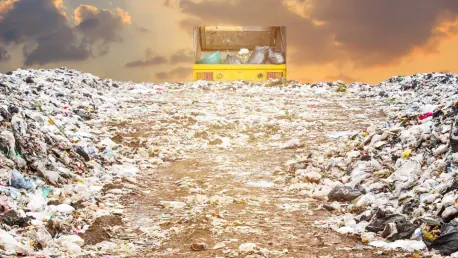The intersection of personal loss, environmental regulations, and judicial decisions is a complex and emotionally charged arena. This article delves into the story of Brenton Marckese, a horse lover whose cherished Clydesdale, Michigan Breeze, died in a tragic hit-and-run accident shortly before Christmas in 2024. Marckese’s efforts to retrieve Breeze’s remains from the Sandtown Landfill in Delaware highlight the challenges and conflicts between individual grief and environmental stewardship.
The Bond Between Man and Horse
A Lifelong Passion for Clydesdales
Brenton Marckese’s connection to Clydesdales began long before he purchased Michigan Breeze in 2014. His passion for these majestic horses was evident in his daily routine and emotional life. Breeze quickly became a significant part of Marckese’s world, and their bond deepened over the years. They spent countless hours together at a ranch near Dover, Delaware, where Marckese helped maintain the property. The relationship between Marckese and Breeze was more than just that of an owner and his horse; it was a profound and personal companionship that significantly impacted Marckese’s life.
This deep-rooted affection for Breeze made the tragic accident all the more devastating for Marckese. The sudden loss of such a beloved animal is heart-wrenching, and the circumstances surrounding Breeze’s death in a hit-and-run incident added salt to the wound. Marckese’s determination to honor Breeze in death is rooted in this profound bond, and his actions following the accident reflect a grieving individual seeking closure for a significant emotional loss. The purchase of Breeze, despite being sight unseen, signifies Marckese’s trust and love for Clydesdales, which speaks volumes about their subsequent bond.
The Tragic Accident
On December 17, 2024, Marckese and Breeze were struck by a vehicle in a devastating hit-and-run accident. Breeze sustained severe injuries and was eventually euthanized. Marckese, hospitalized and medicated, was unaware of Breeze’s fate until his release. He discovered that a contractor had taken Breeze’s remains to the Sandtown Landfill, managed by the Delaware Solid Waste Authority (DSWA). The abruptness with which these events unfolded left Marckese in a state of shock, grappling with both physical injuries and overwhelming grief from losing Breeze.
The fact that Breeze’s remains were taken to a landfill without Marckese’s knowledge added to his despair. For someone who had envisioned a respectful cremation for his cherished companion, the reality of Breeze’s final resting place being a landfill was unbearable. Marckese’s strong aversion to disposing of animal remains in landfills stemmed from his belief that such actions were disrespectful to the animal’s memory. This conviction propelled him into immediate action, demonstrating the lengths an individual could go to when driven by emotional distress and a sense of duty towards a loved one.
The Quest to Retrieve Breeze’s Remains
Initial Attempts and Regulatory Roadblocks
Marckese’s immediate reaction was to retrieve Breeze’s remains from the landfill. He arrived at the site early the next morning, only to be met with stringent regulatory roadblocks. Jason M. Munyan, DSWA’s Chief of Facilities Management, emphasized safety and environmental health concerns, explaining the procedures and risks associated with disturbing a landfill. The process of ensuring that landfill operations comply with environmental regulations is intricate, with layers of compliance protocols designed to safeguard public health and the ecosystem.
Munyan’s role involved managing these complexities and, as he highlighted, the extraction of remains from a landfill site entailed significant risks. The operational integrity of a landfill is maintained through controlled procedures that mitigate contamination and hazards. Disturbing this carefully balanced system could lead to unforeseen consequences, including gas emissions, pathogen spread, and potential breaches in geomembrane liners designed to prevent groundwater contamination. For these reasons, landfill sites are subject to strict regulations that are not bent for personal requests, no matter how heartfelt.
Legal Action and Court Proceedings
On December 23, Marckese’s counsel filed a petition in the Delaware Court of Chancery, asserting a claim of replevin—a legal remedy to recover unlawfully withheld property. The petition sought a temporary restraining order (TRO) to halt further landfill activity and enable Marckese to recover Breeze’s remains. Chancellor Kathaleen St. J. McCormick convened an emergency Zoom hearing on Christmas Eve, underscoring the urgency due to decomposition risks and waste accumulation. This step into the legal realm underscored the determination and desperation in Marckese’s quest to recover his horse’s remains.
Chancellor McCormick’s decision to hold an emergency hearing highlighted the judicial system’s recognition of the time-sensitive nature of Marckese’s plea. However, the legal arguments from both sides presented a scenario where personal grief intersected with broader public safety and environmental considerations. The intricacies of landfill operations were brought to the forefront, with Munyan providing detailed testimony on the regulations and safety measures in place, emphasizing the considerable risks involved in granting Marckese’s request. This legal struggle exemplified the broader conflict between individual desires and the necessity of adhering to established environmental safeguards.
The Complexities of Landfill Operations
Engineering and Regulatory Compliance
Munyan’s testimony provided a comprehensive overview of landfill operations, highlighting the sophisticated engineering and regulatory compliance involved. He explained the foundational geomembrane liner designed to prevent groundwater contamination, the daily soil cover to mitigate odors, pathogens, and vermin, and the intricate gas management system to control toxic and flammable emissions. These explanations underscored the potential dangers and environmental hazards of allowing public access to landfill sites. The engineering precision involved in landfill management ensures that waste is contained without posing a risk to the surrounding environment.
Landfill sites, by their very nature, are complex systems designed to manage waste while preventing adverse environmental impacts. The underlying structure, with its liners and covers, works to isolate waste from the ecosystem. Daily operations involve diligent management practices to control emissions and contaminants, making the process of retrieving remains a task fraught with risk. Any deviation from these established procedures could compromise the integrity of the landfill, triggering a cascade of environmental and safety concerns. Munyan’s testimony made it clear that these compliance protocols serve a critical role in maintaining public health and ecological balance.
Financial and Logistical Challenges
During the December 27 hearing, Munyan pointed to the unprecedented nature of granting such access and the logistical and financial burdens of a safe excavation, estimated at $25,000 per day. He reiterated that no public access for personal item retrieval had been granted in his 19-year tenure with DSWA and stressed the strategic placement of carcasses at the landfill’s bottom layer to minimize visual disturbance. The financial implications of such an operation were significant, reflecting the extensive resources and safety measures required to ensure compliance with environmental regulations during an excavation.
Granting Marckese’s request would set a precedent that could lead to numerous challenges in managing landfill operations. The logistical complexities of safely conducting an excavation in a landfill are extensive, involving specialized equipment and considerable labor, all of which incur substantial costs. This reality, coupled with the potential health hazards posed by disturbing waste layers, formed a formidable argument against the retrieval request. Munyan’s stance was grounded in decades of adherence to strict protocols, reinforcing that exceptions could undermine the entire system’s integrity.
Judicial Deliberations and Decision
Weighing Personal Loss Against Public Health
Chancellor McCormick faced the difficult task of balancing Marckese’s personal loss and empathetic plea against the broader environmental and public health implications presented by Munyan. The judge acknowledged the depth of Marckese’s attachment to Breeze but ultimately emphasized the paramount concern for public health and safety over individual grief. This decision was rooted in the understanding that while personal loss is profound, the overarching responsibility to protect public health and maintain environmental standards cannot be compromised.
The judicial deliberation process underscored the tension between honoring individual emotional appeals and upholding stringent environmental and public health protocols. Chancellor McCormick’s ruling was a reflection of the judiciary’s role in navigating such conflicts, ensuring that established regulations are upheld even when faced with compelling personal narratives. This decision was a testament to the enduring principle that public welfare and environmental safety must take precedence, highlighting the complexities that arise when personal tragedies intersect with regulatory frameworks designed to protect the collective good.
The Precedent and Environmental Stewardship
Chancellor McCormick’s ruling highlighted the inherent risks of setting a precedent that could lead to hazardous disruptions in meticulously managed landfill operations. The decision underscored the delicate balance and complexity of landfill management, which must safeguard both the environment and public health from potential leachate contamination, gas emissions, and pathogen spread. By denying Marckese’s request, the court emphasized the critical importance of maintaining strict adherence to environmental regulations.
The potential implications of granting such requests extend beyond immediate logistical and financial burdens. Allowing public access to landfills for personal item retrieval could create expectations that disrupt the operational stability of landfill sites. This precedent would impose additional strain on already intricate management processes, increasing the likelihood of compliance breaches and environmental hazards. McCormick’s decision served as a reminder that environmental stewardship involves difficult choices, often requiring the prioritization of broader public health over individual desires.
The Broader Implications
Personal Loss Versus Environmental Regulations
The case of Brenton Marckese and Michigan Breeze presents a poignant dichotomy: personal loss versus environmental stewardship. The broader trend emphasized a consensus on strict landfill regulations and engineering precision as essential safeguards, prioritizing collective welfare over individual exceptions. This case underscored the challenges faced by individuals and institutions in balancing emotional appeals with the necessity of stringent regulatory adherence.
Marckese’s experience sheds light on the profound impact of personal loss and the lengths individuals may go to seek closure. However, it also highlights the judiciary’s critical role in maintaining the delicate equilibrium between personal and environmental considerations. This narrative illustrates the complex interplay between human emotion and the rigid frameworks necessary to protect public health and the environment, offering a nuanced perspective on the multifaceted issues at play in such scenarios.
The Role of the Judiciary
The intersection of personal loss, environmental regulations, and judicial decisions often proves to be a complicated and emotionally intense area. This article explores the poignant story of Brenton Marckese, a devoted horse lover, whose beloved Clydesdale horse, named Michigan Breeze, tragically perished in a hit-and-run accident just before Christmas in 2024.
Marckese’s deep bond with Michigan Breeze made the loss even more heartbreaking, and his struggle to retrieve the horse’s remains from the Sandtown Landfill in Delaware brought to light the tension between individual grief and environmental policies. Sandtown Landfill, like other landfills, operates under strict environmental regulations designed to manage waste and protect the environment. However, these rules can clash with individual needs, particularly in cases involving personal loss and the desire for a proper goodbye.
Marckese’s journey underscores the conflict between personal emotions and the often impersonal nature of environmental laws. Efforts to balance these two aspects reveal the extent to which individuals must navigate bureaucratic processes to find closure while adhering to regulations meant to serve the greater good. The story of Brenton Marckese and Michigan Breeze serves as a compelling instance where human experience intersects with legal and environmental frameworks, posing questions about how society can better address such deeply personal issues within the confines of broader regulatory systems.









